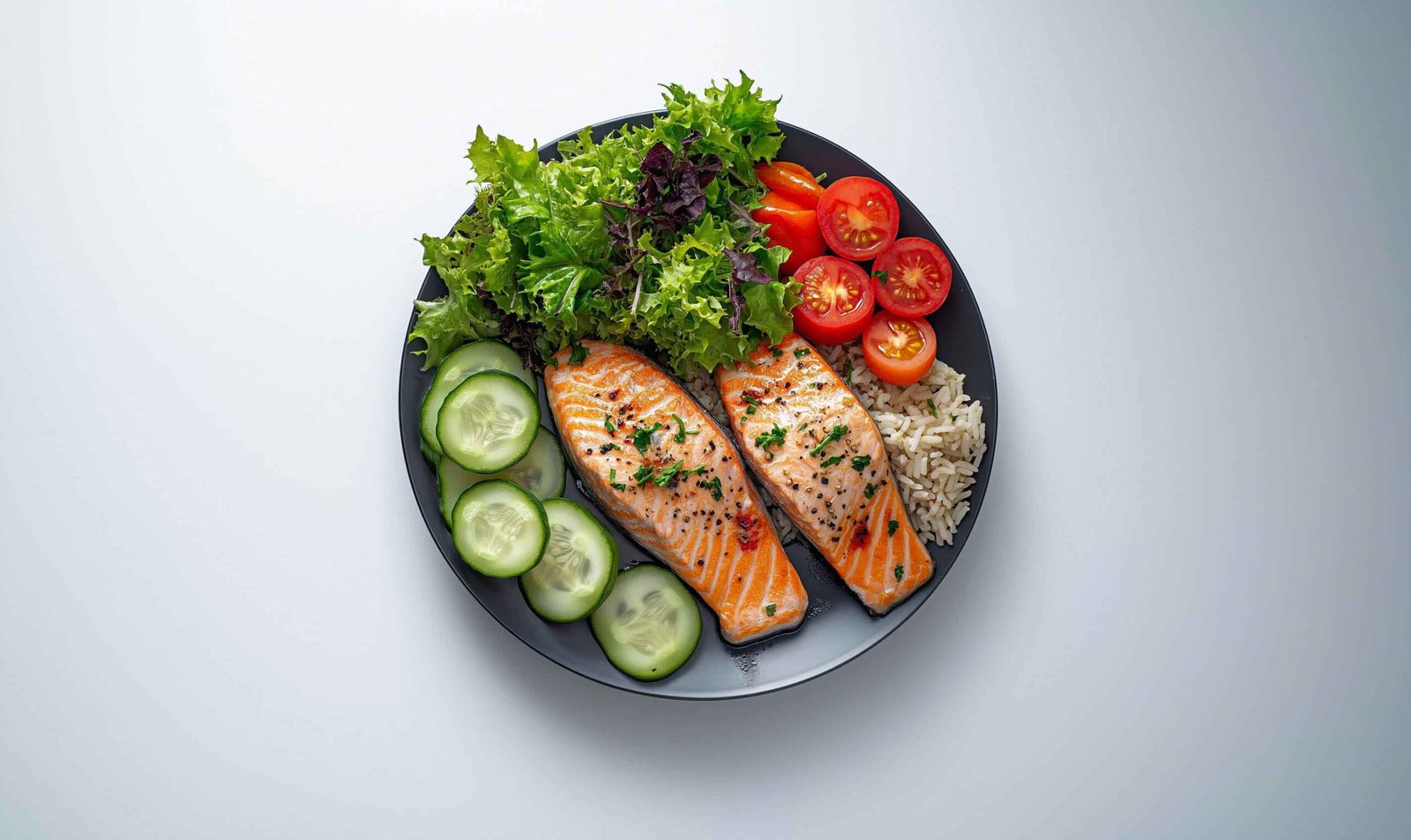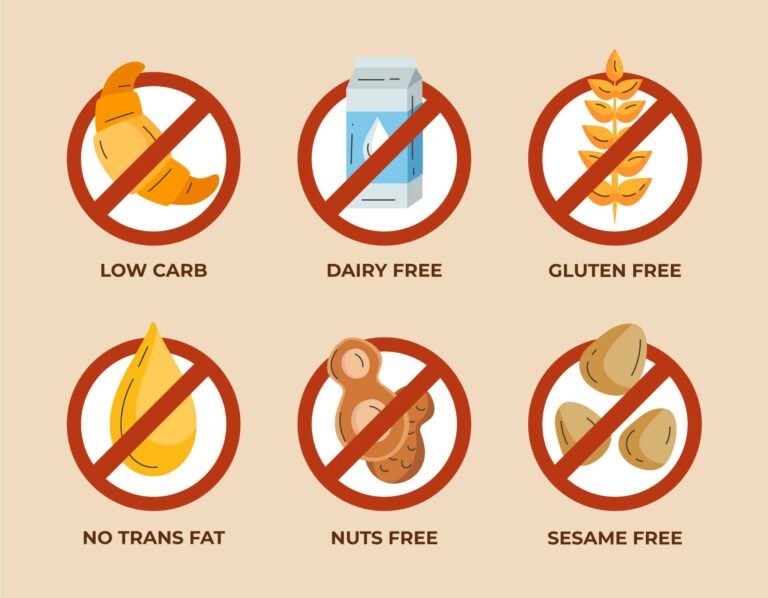This post may contain affiliate links — Please read our Disclaimer below.

In today’s fast-paced world, where oversized meals and indulgent treats are the norm, portion control has become a vital tool in crushing overeating to maintain a healthy diet and lifestyle. Learning to manage serving sizes is crucial for anyone aiming to prevent overeating, maintain a healthy weight, or simply improve their overall eating habits.
The good news? Mastering portion control is easier than you might think. This guide will walk you through practical tips and psychological tricks to help you take charge of your portions, whether you’re dining at home or eating out.
Before we dive in lets take a look at the common symptoms and risks involved with overeating:
Symptoms of Overeating: How to Know if You’re Doing It

Recognizing the signs of overeating can be tricky because it’s not always about the volume of food consumed in one sitting. Some subtle and not-so-subtle signs can help you determine if you’re overeating regularly.
- Feeling Uncomfortably Full
One of the most apparent symptoms of overeating is feeling uncomfortably full after meals. If you find yourself constantly eating past the point of satisfaction to the point where you feel bloated or even nauseous, this is a clear sign you may be consuming more than your body needs.
- Eating Quickly
When you eat too fast, you may not give your brain enough time to register that you’re full. It takes around 20 minutes for your body to signal satiety, so if you frequently finish meals in under 10 minutes, you might not realize you’re overeating until after you’re done.
- Eating When You’re Not Hungry
Overeating isn’t always driven by hunger. Emotional triggers like stress, boredom, or even happiness can cause us to reach for food even when we’re not hungry. Pay attention to why you’re eating. Are you truly hungry, or are you eating out of habit or emotion?
- Feeling Guilty or Shameful After Eating
If you often feel guilt or shame after eating, especially after consuming larger portions than planned, this could be a sign of overeating. These feelings typically arise when we eat for reasons beyond hunger, like emotional triggers, or when we consume foods we know aren’t aligned with our health goals.
- Constantly Thinking About Food
Obsessing over your next meal or snack, even when you’re not physically hungry, can also indicate a problem with overeating. When food dominates your thoughts throughout the day, it’s worth exploring whether you’re using it as a way to cope with emotions or stress.
- Weight Gain
Unexplained weight gain over time, especially if your activity levels have stayed the same, may indicate overeating. Monitoring your portion sizes and assessing whether you’re eating balanced meals can help in managing your weight effectively.
Why Portion Control Matters
Portion control is more than just a dieting trend; it’s a foundational element of healthy eating. Properly managing your food portions helps to regulate calorie intake, prevent overeating, and maintain a balanced diet. Over time, consistently consuming large portions can lead to weight gain, obesity, and related health issues such as heart disease, diabetes, and high blood pressure.
The practice of portion control is not about depriving yourself but about making mindful choices that align with your health goals, especially weight loss. By understanding the appropriate serving sizes for different food groups and implementing strategies to manage portions effectively, you can enjoy your favorite foods without the guilt or the extra calories.
For more on the proper proportions within the serving sizes themselves read more here.
Top Tips for Portion Control

- Use Smaller Plates
- One of the simplest yet most effective tricks for managing portion sizes is to use smaller plates. This strategy works because it takes advantage of an optical illusion known as the Delboeuf illusion, where the same amount of food appears more substantial on a smaller plate than on a larger one. As a result, you’re likely to feel more satisfied with a smaller portion.
- Measure Portions
- When it comes to portion control, accuracy is key. Using measuring cups, kitchen scales, or portion control tools can help ensure that you’re eating the right amounts. For example, a serving of pasta is typically about one cup cooked, while a serving of protein like chicken or fish is about three to four ounces, roughly the size of a deck of cards. Measuring out your food can prevent unintentional overeating and help you become more aware of appropriate serving sizes.
- Be Mindful of Seconds
- It’s easy to go for a second helping, especially when the food is delicious. However, this can lead to consuming more calories than intended. To manage this, wait for about 10 minutes after finishing your first plate to assess whether you’re truly still hungry. Often, the feeling of fullness takes time to register, and by waiting, you may find that you don’t need that second serving after all.
- Avoid Screen Time Eating
- Eating while distracted, such as in front of the TV or while scrolling on your phone, can lead to mindless overeating. When you’re not paying attention to your food, you’re less likely to notice when you’re full, and more likely to overeat. To avoid this, make mealtime a screen-free zone. Focus on your food, savor each bite, and pay attention to your body’s hunger and fullness cues.
- Pre-Portion Snacks
- Snacks can quickly add up, especially when eaten straight from the package. To control snack portions, pre-portion them into individual servings as soon as you buy them. This way, when you’re feeling snacky, you can grab a pre-measured portion instead of mindlessly munching through a whole bag of chips or a box of cookies.
Disorders Related to Overeating
Overeating isn’t just about lack of willpower or momentary indulgence—it can be linked to underlying psychological and physiological issues. Understanding the disorders that are commonly associated with overeating can shed light on why some people struggle more than others with portion control.
- Compulsive Overeating
Compulsive overeating, or binge eating disorder (BED), is characterized by regularly consuming large amounts of food in a short period, often to the point of discomfort. People with this disorder may feel a lack of control during these episodes and often feel shame or guilt afterward. Unlike bulimia, they do not purge after eating. BED is recognized as a serious mental health condition that can lead to obesity, diabetes, and other health issues if left untreated. Therapy and medication are often necessary to help individuals manage this disorder.
- Obesity
Obesity is a complex condition often linked to overeating. It’s characterized by an excessive accumulation of body fat and is commonly associated with a higher risk of chronic diseases, including heart disease, stroke, and type 2 diabetes. While obesity can result from various factors like genetics and lifestyle, overeating plays a significant role. Emotional triggers like stress, anxiety, or depression can lead to overeating, especially of high-calorie, low-nutrient foods. Managing portions, especially when combined with mindful eating practices, is one way to prevent or manage obesity.
- Overeating and ADHD
There’s increasing evidence to suggest that people with Attention Deficit Hyperactivity Disorder (ADHD) may be more prone to overeating. ADHD affects impulse control, which can make it difficult for individuals to regulate their eating habits. Hyperactivity and inattention might also distract from the signals of fullness. Studies show that people with ADHD are at higher risk of developing obesity and related health issues, as they might use food as a coping mechanism or simply forget to eat throughout the day, leading to overeating later.
- Overeating and Autism
Autism Spectrum Disorder (ASD) can also influence eating patterns. Sensory sensitivities, difficulty with routines, and anxiety can lead to issues with portion control or a preference for certain types of food. Some individuals with autism may overeat certain comfort foods, while others may avoid eating altogether due to texture or sensory challenges. Parents and caregivers can help by creating structured meal times and practicing portion control, helping reduce the risk of obesity and other health issues.
- Overeating and Anxiety, and Depression
Emotional eating is a common issue for people dealing with anxiety and depression. Many individuals use food as a way to self-soothe during stressful or emotional periods. Carbohydrate-heavy or sugary foods, in particular, may temporarily boost serotonin, the brain chemical associated with mood regulation, leading to overeating. Unfortunately, this coping mechanism often leads to weight gain, exacerbating feelings of anxiety or depression, creating a vicious cycle. Addressing the emotional root causes and practicing portion control can help manage overeating in individuals struggling with these conditions.
The Psychology of Portion Control

Understanding the psychological factors behind eating can be a powerful tool in mastering portion control. Often, our eating habits are influenced more by our environment and emotions than by actual hunger.
Mindful Eating
Mindful eating is the practice of paying full attention to the experience of eating and drinking, both inside and outside the body. It involves noticing the colors, smells, textures, flavors, temperatures, and even the sounds (crunch!) of your food. By slowing down and being more present during meals, you’re more likely to recognize when you’re full, making it easier to control portions.
In addition, it can help digestion to simply sit a real table, instead of on your couch in front of the TV. For more reading on this see below at the end of the article.
Avoiding Emotional Eating

Emotional eating, or eating in response to stress, boredom, or other emotions rather than hunger, is a common challenge. To combat this, try to identify triggers that lead to emotional eating and find alternative coping mechanisms, such as taking a walk, meditating, or talking to a friend.
The Power of Presentation

The way food is presented can also impact how much we eat. Studies have shown that people tend to eat more when food is served on larger plates or when there’s a greater variety of foods on the plate. To control portions, try using smaller plates and bowls, and be mindful of how food is arranged. Creating a balanced plate with a variety of colors and textures can make a smaller portion feel more satisfying.
You can also try taking a food styling course online over at Udemy.
Practical Advice for Dining Out
Dining out can be one of the biggest challenges when it comes to portion control. Restaurant portions are often much larger than the recommended serving sizes, and it can be tempting to eat everything on your plate. Here are some tips to help you manage portions when eating out:
- Share Dishes
- One of the easiest ways to control portions at a restaurant is to share dishes with a dining partner. Splitting an entrée or dessert not only helps with portion control but also allows you to enjoy a wider variety of dishes without overindulging.
- Choose a la Carte Items
- Opting for a la carte items rather than full meals can help you control the size of your portions. For example, ordering a grilled chicken breast with a side of vegetables allows you to create a balanced meal without the extra calories that often come with appetizers, bread, or large sides.
- Avoid Buffets
- Buffets can be a minefield for portion control. With so many options and the temptation to “get your money’s worth,” it’s easy to overeat. If you do find yourself at a buffet, start with a smaller plate, fill it with vegetables and lean proteins, and avoid going back for seconds.
- Take Home Leftovers
- If a restaurant serves large portions, don’t feel obligated to finish everything on your plate. Ask for a to-go box when your meal arrives and immediately set aside half of your food for later. This way, you can enjoy a satisfying meal without overeating and have leftovers for another meal.
How Portion Sizes Are Determined in the U.S. and Around the World
Portion sizes in the United States are largely influenced by a combination of government guidelines, food industry practices, and cultural factors. Understanding who determines these portions and how they differ from other countries reveals why the U.S. has some of the largest portion sizes in the world, contributing to issues like overeating and obesity.
The Role of the FDA and USDA in Portion Control

In the United States, two major organizations play key roles in determining portion sizes: the Food and Drug Administration (FDA) and the U.S. Department of Agriculture (USDA). These agencies establish serving sizes based on scientific data, consumer behavior, and food consumption patterns. The serving sizes found on Nutrition Facts labels are regulated by the FDA and are defined in terms of “Reference Amounts Customarily Consumed” (RACCs), which represent how much people typically eat or drink in one sitting. These portions are meant to help consumers make informed choices, though they don’t always reflect the healthiest option.
For instance, the USDA’s MyPlate guidelines recommend portion sizes based on different food groups and nutritional needs, providing a visual representation to help Americans balance their plates with proper portions of vegetables, grains, proteins, and fats. While these guidelines aim to promote healthy eating, actual portion sizes served in restaurants and fast food chains are often much larger than the recommended amounts.
Portion Sizes in Restaurants and Fast Food Chains
One of the main reasons for large portion sizes in the U.S. is the influence of the food industry. Over the past few decades, food portions have grown significantly, particularly in restaurants and fast-food chains, where portion sizes often exceed government recommendations. These larger portions, known as “portion distortion,” have contributed to the normalization of overeating.
In response to consumer demand for more value, many companies increased portion sizes, which led to larger plates, bigger drink sizes, and more calorie-dense meals. The “supersize” trend is a prime example of this phenomenon. Unfortunately, the more people become accustomed to these oversized portions, the harder it becomes to recognize proper portion sizes.
Comparing Portion Sizes Across the World

Portion sizes vary significantly from country to country, with the U.S. often serving larger amounts of food compared to other nations. Let’s look at some examples:
- France
France is known for its smaller portion sizes, and the country’s food culture emphasizes quality over quantity. French meals are typically eaten at a slower pace, and portion control is integrated into their approach to dining. For instance, desserts in France, such as pastries, are usually much smaller than the portions served in American restaurants. The French also prioritize meals with several courses, allowing people to eat smaller portions while still feeling satisfied. - Japan
Japanese cuisine places a strong emphasis on moderation and balance. The traditional Japanese diet consists of small portions, with meals made up of various dishes like rice, fish, vegetables, and miso soup. One example is the bento box, which offers a variety of small, perfectly portioned foods, making it easy to manage caloric intake while still enjoying a variety of flavors. This approach, along with Japan’s focus on fresh, seasonal ingredients, helps maintain portion control without sacrificing satisfaction. - Italy
Italian portions, especially in more traditional settings, are also smaller compared to U.S. portions. While Italian cuisine is rich in pasta, bread, and cheese, these foods are typically served in moderate amounts. In contrast to the giant pasta plates common in American restaurants, Italians often consume pasta as a small first course or side dish, not the main event. Additionally, Italian meals are often balanced with salads, vegetables, and fruit. - The United Kingdom
In the UK, portion sizes are generally closer to those in the U.S., but they are still somewhat smaller, particularly in home-cooked meals. British portions are often less excessive than American fast-food portions, although in recent years, there has been an increase in larger portion sizes in chain restaurants and takeout.
Why Are American Portions So Much Bigger?
The reasons for larger portion sizes in the U.S. are varied but can be attributed to several factors:
- Consumer Demand: Americans often equate larger portions with better value, leading to an increase in portion sizes across the food industry.
- Economic Factors: Food in the U.S. is relatively inexpensive compared to other countries, allowing restaurants and fast-food chains to increase portion sizes without significantly raising prices.
- Marketing: Companies use large portions as a marketing tool, offering “value meals” and “combo deals” that encourage consumers to eat more.
- Cultural Norms: In the U.S., eating out and “supersized” meals have become normalized. This contributes to people expecting and consuming larger portions, which can distort their perception of a proper serving size.
Portion sizes in the U.S. differ greatly from those in many other countries, often leading to higher caloric intake and an increased risk of overeating. By understanding how portions are determined and being mindful of these cultural differences, individuals can make better choices and stay within healthy limits when managing their food intake.
Portion Control And Intermittent Fasting

Intermittent fasting (IF) has gained popularity as a method for weight management and improving metabolic health. But how does it relate to portion control? Surprisingly, intermittent fasting can serve as a powerful tool in managing both the amount and timing of food consumption, which directly impacts portion control habits.
What is Intermittent Fasting?
Intermittent fasting is an eating pattern that cycles between periods of eating and fasting. Unlike traditional diets that focus on what you eat, intermittent fasting is more about when you eat. The most popular forms include the 16/8 method (fasting for 16 hours and eating during an 8-hour window), the 5:2 method (eating normally for five days and reducing calorie intake for two), and alternate-day fasting.
How Intermittent Fasting Helps with Portion Control
- Structured Eating Windows
One of the main ways intermittent fasting aids in portion control is by creating a defined window for eating. For example, if you follow the 16/8 method, you only have an 8-hour period during which you can eat. This naturally limits the number of meals and snacks you can consume, making it easier to stick to smaller, controlled portions. With a restricted eating window, there is less opportunity for mindless grazing, which can often lead to overeating. - Better Awareness of Hunger Signals
Fasting can help people become more attuned to their hunger and fullness cues. After a period of fasting, individuals may find that they can better distinguish between true hunger and emotional or habitual eating. This improved awareness encourages people to eat until they are satisfied, not stuffed, which is crucial for portion control. - Regulating Calorie Intake
While intermittent fasting doesn’t explicitly require calorie counting, it can naturally reduce overall calorie intake. Eating within a limited time frame often means consuming fewer calories because there’s less time to eat multiple meals or large portions. People practicing intermittent fasting may find that they don’t need to eat as much to feel full, leading to better portion control without strict dieting. - Preventing Overeating
Many people struggle with overeating because they snack throughout the day or eat late at night. Intermittent fasting sets clear boundaries, which can help prevent late-night binging or frequent snacking. Knowing that there is a designated time for eating helps create structure and reduces the tendency to overeat during meals. - Balancing Blood Sugar Levels
Studies have shown that intermittent fasting can improve insulin sensitivity and help stabilize blood sugar levels. This can reduce cravings and the urge to overeat, particularly when it comes to sugar-rich, high-calorie foods. By reducing cravings, intermittent fasting may make it easier to stick to smaller, more balanced portions at meal times. - Maintaining Muscle While Losing Fat
Intermittent fasting can also be an effective method for fat loss while preserving muscle mass. During the fasting period, your body uses stored fat for energy, leading to fat loss. However, because you’re eating in a limited window, it’s important to maintain adequate protein intake to preserve muscle. This focus on nutrient-dense meals with appropriate portion sizes can support muscle maintenance and prevent overconsumption of unnecessary calories.
The Challenges of Portion Control During Intermittent Fasting
While intermittent fasting can be helpful for portion control, there are potential challenges. Some individuals may overeat during their eating windows, believing they need to “make up” for the time they spent fasting. This can lead to larger-than-needed portions, negating the benefits of fasting. Additionally, if you consume calorie-dense, nutrient-poor foods during your eating periods, it’s easy to consume more calories than your body needs, even in a restricted time frame.
To combat this, focus on mindful eating and balance in your meals. Pay attention to portion sizes and aim to include a balance of proteins, fats, and carbohydrates, along with plenty of vegetables and fiber-rich foods to help you feel satisfied. Staying mindful of your portion sizes, even while practicing intermittent fasting, is crucial to reaping its full benefits.
Incorporating intermittent fasting with portion control strategies allows individuals to manage their caloric intake and avoid overeating while improving their awareness of hunger signals. By combining these two approaches, many people find it easier to reach their weight loss or health goals while still enjoying their favorite foods in moderation.
Conclusion: A Balanced Approach to Eating

Portion control is not about strict dieting or denying yourself the foods you love. It’s about making mindful choices that allow you to enjoy a variety of foods while maintaining a healthy balance. By incorporating the tips and strategies outlined in this guide, you can take control of your portions and create a more balanced, satisfying approach to eating.
Remember, the key to successful portion control is consistency. By regularly practicing these habits, they will become second nature, helping you maintain a healthy weight, prevent overeating, and enjoy your meals to the fullest.
Further Reading and Resources
For those interested in learning more about portion control and healthy eating, consider exploring the following resources:
- Harvard T.H. Chan School of Public Health: Offers a comprehensive guide on healthy eating, including portion control tips and the benefits of a balanced diet.
- The American Heart Association: Provides practical advice on portion sizes and how to make healthier choices at home and when dining out.
- Mindful Eating: Books and websites dedicated to the practice of mindful eating can help deepen your understanding of the psychological aspects of eating and portion control.
By making portion control a priority, you’re not just managing your food intake; you’re taking a significant step toward a healthier, more balanced lifestyle.
Disclaimer: For Your Health and Safety
Remember, the information provided in this blog post is for educational purposes only and should not be considered medical advice. Always consult with a healthcare provider or registered dietitian before making any significant changes to your diet, especially if you have underlying health conditions.



